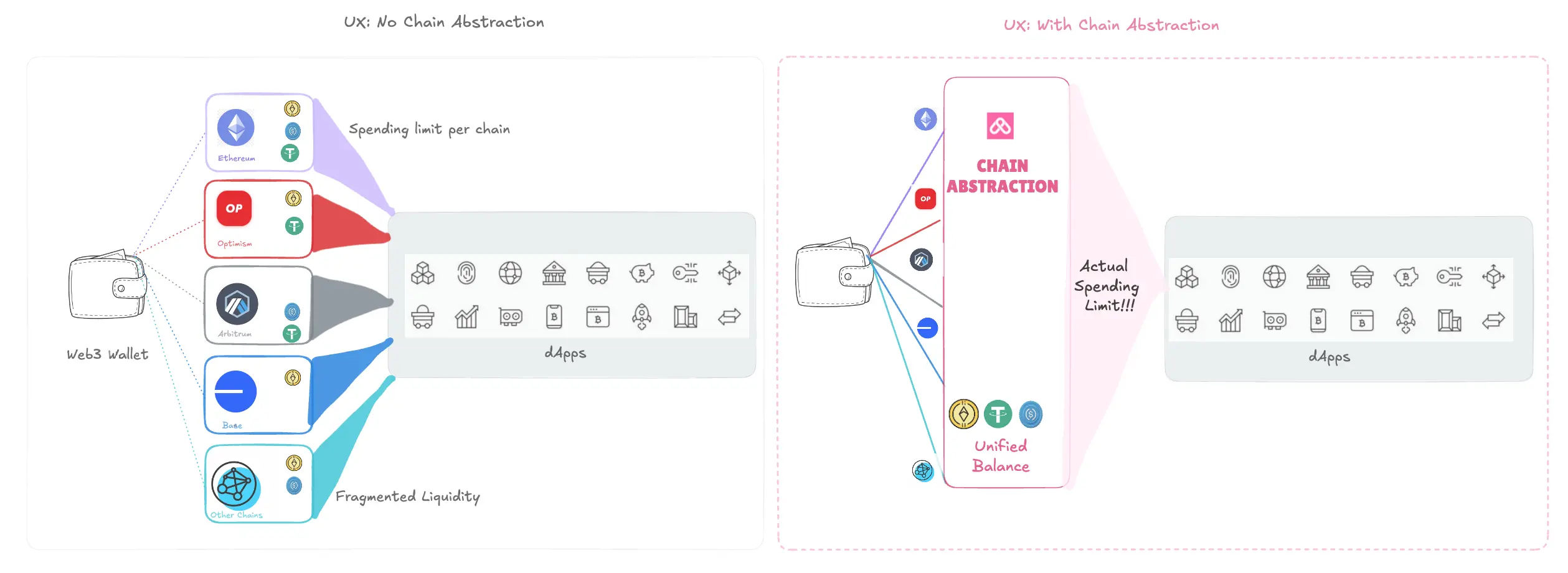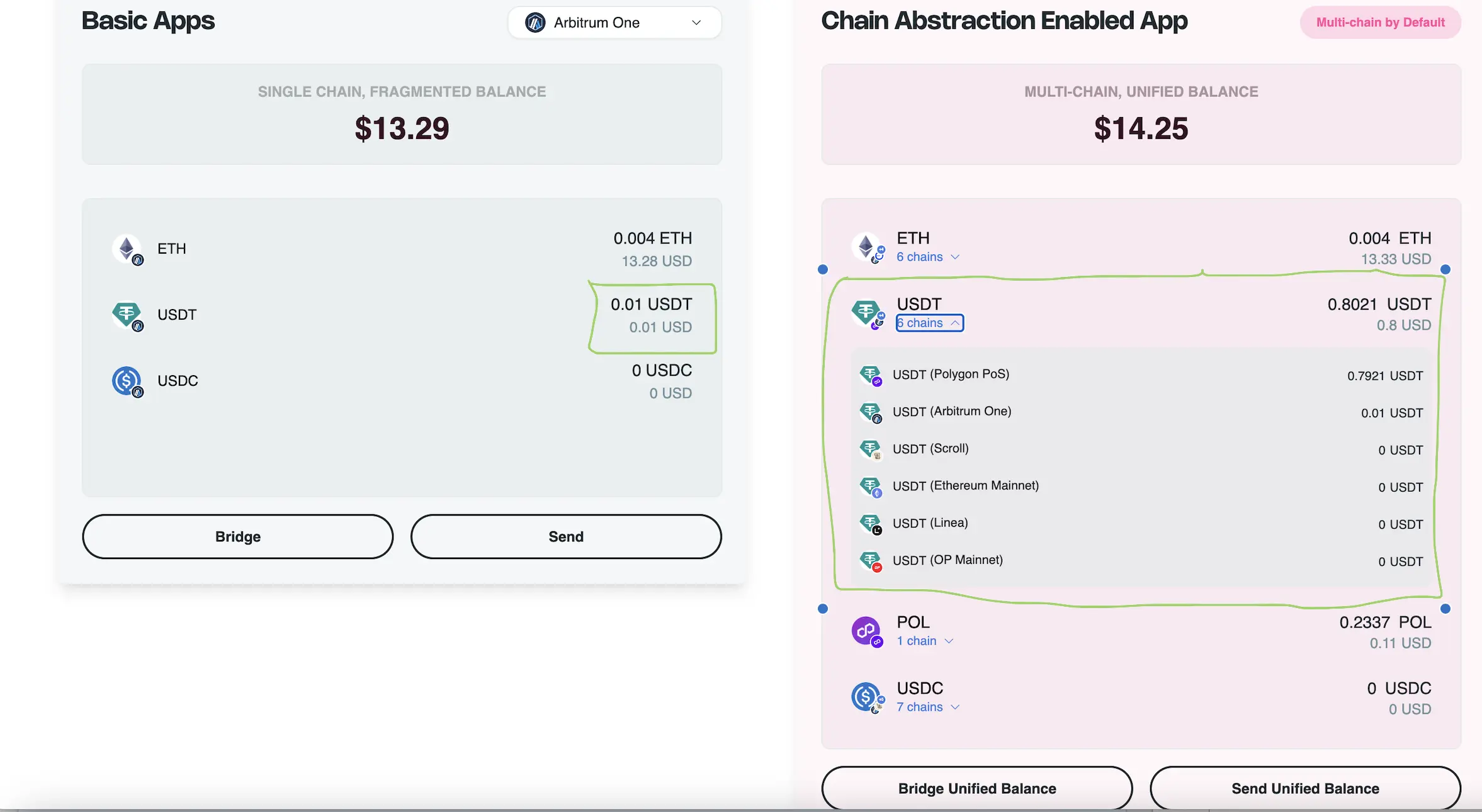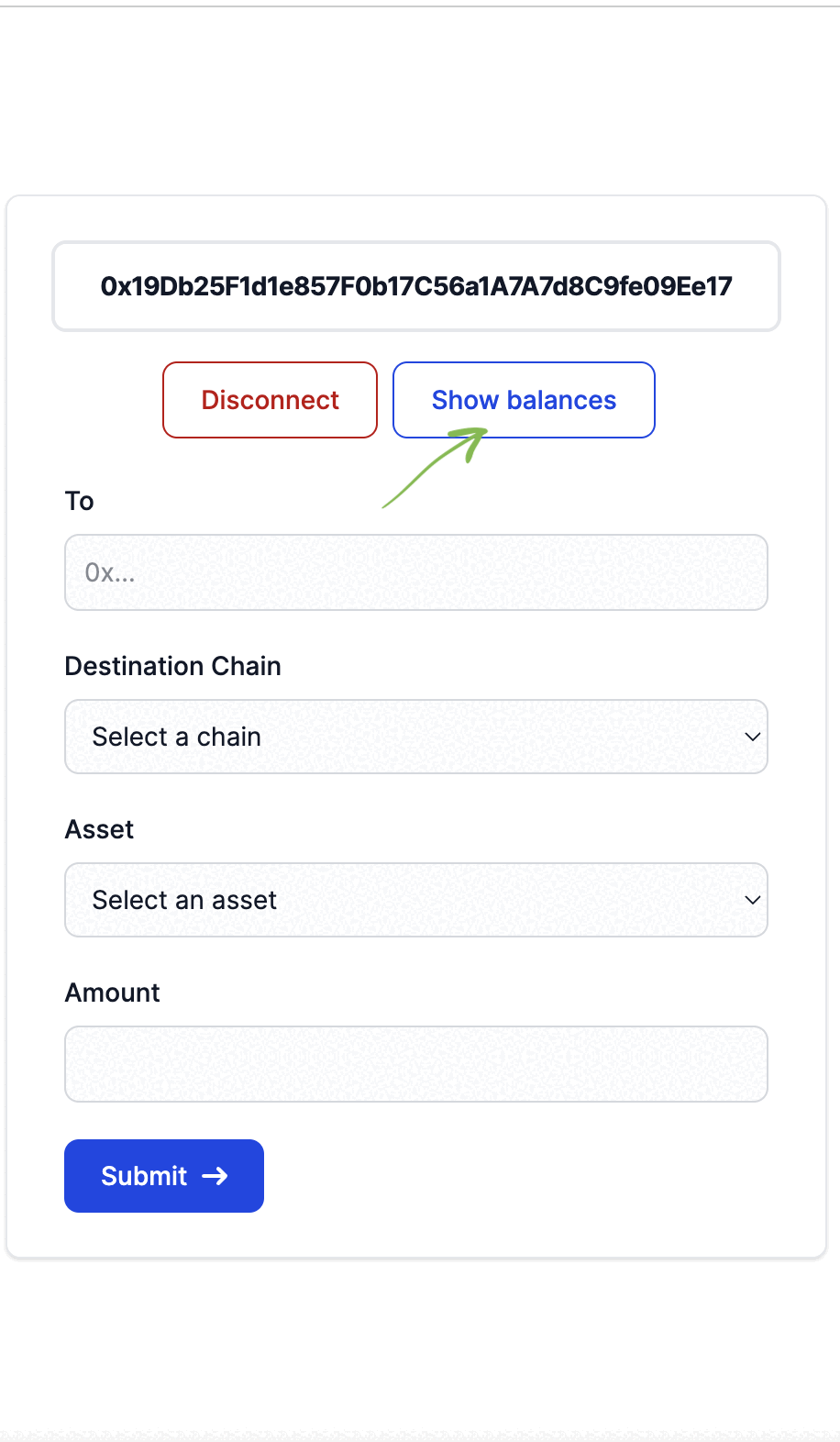Chain Abstraction Architecture
Estimated time to read: 5 minutes
Before we get into the details of Arcana's Chain Abstraction (CA) architecture, let's first understand some key concepts.
What is CA?
For Web3 app users, managing multiple chains, tokens, and accounts often leads to liquidity fragmentation in their wallets. Even with sufficient overall token asset balance, users struggle to transact because funds are scattered across several chains. To transact, users must convert assets from two or more source chains into those accepted on the target chain. This is a complex, time-consuming process not everyone can navigate.
Chain Abstraction lets users view and access a unified balance across chains associated with their wallet account, enabling them to transact on any chain. It shifts the focus from having to bootstrap funds to transact on the destination chain to specifying a clear intent for the transaction. This simplifies the transaction process and makes it accessible to a wider audience.

Unified balance
Unified balance shows all the liquidity in a user's EOA account across multiple chains in one view. It lets users transact seamlessly on any chain without needing bridges or pre-provisioning gas for token swaps. Chain abstraction handles all the complexity involved in a cross-chain transaction while enabling better UX through a single intent approval.
For instance, let us take the case where a user intends to spend 18 USDC on Scroll and does not have any balance on Scroll.
- Optimism: 0.1 ETH, O USDT, 0 USDC
- Arbitrum: 0 ETH, 12 USDT, 0 USDC
- Base: 0 ETH, 10 USDT, 0 USDC
- Scroll: 0 ETH, 0 USDT, 0 USDC
To spend 18 USDC on Scroll (destination chain) with the given liquidity fragmentation, it would typically require multiple clicks and steps for swapping or bridging different assets available on the source chains, so that user can convert the assets to the desired token balance on Scroll.
Through chain abstraction and ability to swap cross-chain, users have the convenience to view the consolidated token balance across supported tokens and chains. This simplifies the process of sending 18 USDC on Optimism, as users can sign the intent without the need for bridging, swapping, or considering the optimal routes.
The cross-chain swap enables users to:
- Spend assets on any destination chain without prior liquidity.
- Collate payable amount by combining multiple supported assets across source chains to address liquidity fragmentation.

Wagmi Plug & Play Widget
Arcana CA Wagmi SDK provides a plug and play widget that displays the Unified balance associated with the user's wallet address. This widget is available only for the Wagmi apps.
Follow these steps to use this widget:
- Install and integrate the app with the Arcana CA SDK.
- Use
CAProviderto enable the plug-and-play unified balance widget in the app. Learn more...

Allowance
Allowances activate Arcana Network's Chain Abstraction feature.
Allowances must be set up to enable a chain abstracted transaction that involves multiple source chains. With allowance setup, users can unlock the fragmented liquidity across multiple chains in their EOA. Effectively, this lets the user spend on any destination chain—even with insufficient balance on the destination chain.
By approving allowances for chain abstraction on the source chains, users can:
- Spend anywhere with funds from multiple chains.
- Bypass bridging to enable liquidity on the destination chain.
- Transact seamlessly across chains.
- Setup once, use repeatedly.
As part of allowance setup, users permit Arcana Vault contracts on the source chains to collect the funds required to execute the transaction seamlessly on the destination chain.
Note that the allowance set up transaction itself requires gas fee. This gas fee is payable by the user. In some cases, Arcana may sponsor gas fee for the allowance setup.
By default, the allowance limit for each supported chain is set to unlimited. This default setting ensure that all the supported tokens on the chain can be utilized as the unified balance available to spend. The protocol can collect the required funds according to the allowance limit and pay for the chain abstracted transactions on any destination chain. Developers can choose to modify the default allowance limits via the setOnAllowanceHook.
Benefits
Chain abstraction and unified balances simplify and streamline Web3 transactions by offering:
- Lower Complexity: Users specify their desired outcome and maximum price. Behind the scenes, solvers handle swaps, conversions, and routing securely and transparently.
- Unified Liquidity: Users see a consolidated view of their assets across all chains without needing manual bridges or swaps.
- Simplified UX: It eliminates the technical and time-consuming multi-step hurdles, creating a seamless experience for both experts and casual users by eliminating the clutter between user expectation and reality of blockchain ecosystem.
- Streamlined DX: Developers can enable unified balances in dApps without altering existing stacks. With the Arcana Chain Abstraction SDK, they can integrate seamlessly—no need to write smart contracts or manage chain switching for transactions on new chains.
Arcana CA Offerings
Arcana has two CA offerings, one targeted at the Web3 Users and the other for Web3 builders and developers.
- Web Apps: Arcana CA SDK
- Wagmi Apps: Arcana CA Wagmi SDK
- Arcana Wallet (Standalone)
Architecture
Arcana's Chain Abstraction (CA) protocol manages balances across multiple chains and tokens in Web3 apps. It solves liquidity fragmentation by enabling a unified balance across supported chains. The Arcana Vault smart contracts on each supported chain and the solver ecosystem are two key parts of the Arcana CA protocol. There’s no auction; it’s a first-come, first-served system where the first solver to accept an intent gets to fulfill it.
The user's EOA state and intents are managed across multiple chains. Approved intents are published for 'solvers' to fulfill. Solvers compete to fulfill these intents and provide liquidity on the destination chain. The protocol handles state transitions and settles solver payments using transaction netting.

CA Protocol
- Developer sets up Arcana Chain Abstraction settings enabling cross chain transactions on selected chain types and required allowances.
- App users are required to permit the allowance values or reconfigure them if the app allows. Allowances enable Arcana Vault to collect required funds from the EOA account on one or more source chains, as per the user's intent.
- User submits an intent to spend
ntokens on a destination chain Y and transact via a Web3 app. - Arcana verifies that user has sufficient funds across the source chains in the user's EOA account and adequate allowances are pre-configured to enable chain abstraction, pay gas fees.
- Funds are moved to the Arcana Vault and user's intent is announced to all listening solvers.
- The assumption is that one of the available solvers in the system will agree to service the user's intent. As of today, only Arcana solver is supported. We are working with partners to onboard trusted third-party solvers into the ecosystem.
- Once the solver services the intent and provides the necessary liquidity on the desired destination chain into the user's EOA, the user can instantly spend it.
- Arcana takes care of managing the settlement at the agreed upon periodicity with the successful solvers. The settlement does not happen after every user transaction but after netting and verification process.
- In case a transaction fails, or times out waiting for a solver, user's funds deposited from the source chain are refunded within a stipulated time period after verification.